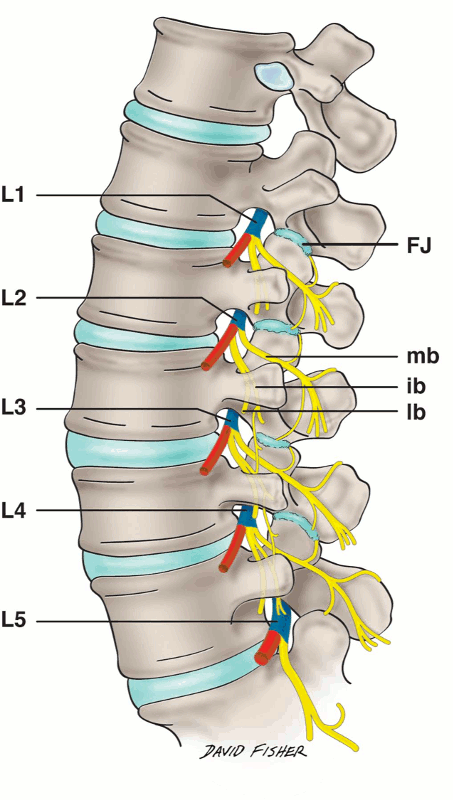The lumbar spine, or lower back, is a crucial and complex part of the human body consisting of five vertebrae located between the thoracic spine and the sacrum. It is responsible for providing support, stability, and flexibility to the upper body while also enabling movements such as bending, twisting, and lifting.
Several nerves are closely associated with the lumbar spine, which play a significant role in transmitting signals between the brain and the lower extremities. The most notable of these nerves are the lumbar spinal nerves, also known as the lumbar nerve roots. These nerves emerge from the spinal cord and exit the vertebral column through small openings between the adjacent vertebrae.
The lumbar spinal nerves branch out across the lower back area, innervating different regions and structures. They provide motor control to the muscles of the lower back, hips, buttocks, thighs, and legs. Additionally, they transmit sensory information from these areas back to the central nervous system, allowing us to perceive sensations such as touch, temperature, and pain.
In addition to the lumbar spinal nerves, the lumbar plexus is another key network of nerves associated with the lumbar spine. The lumbar plexus is formed by the ventral rami of the lumbar spinal nerves and it supplies motor and sensory innervation to the abdominal wall, groin, and anterior thigh. It also gives rise to the femoral nerve, which is responsible for controlling the quadriceps muscle and transmitting sensations from the thigh and knee.
However, injuries or conditions affecting the lumbar spine can potentially compress or irritate these nerves, leading to various symptoms. Common examples include sciatica, a condition characterized by radiating pain down the buttock and leg due to compression of the sciatic nerve, which arises from the lumbar spine. Other symptoms may include numbness, tingling, muscle weakness, or even loss of bladder or bowel control, depending on the extent of nerve involvement.
Understanding the nerves associated with the lumbar spine is crucial for diagnosing and treating conditions such as herniated discs, spinal stenosis, or degenerative disc disease. It allows healthcare professionals to target specific nerves or nerve roots for intervention, whether through medication, physical therapy, or surgical intervention, in order to alleviate symptoms and restore function to the affected individual.
What do the nerves between L5 and S1 control?
These nerves also control movements of the hip and knee muscles. L5 spinal nerve provides sensation to the outer side of the lower leg, the upper part of the foot, and the web-space between the first and second toe. The L5 spinal nerve controls hip, knee, foot, and toe movements.
What nerves are affected by L5 and S1?
We think that large, extruded L5-S1 disc herniations may affect the superior hypogastric plexus or pre-sacral nerve which is situated anterior to the last lumbar vertebra, the middle sacral artery, the lumbosacral intervertebral disc.
What does the L4-L5 nerve control?
The L5 nerve root exits the spine at the level of the L4-L5 vertebrae and innervates (supplies sensation to) the muscles of the thigh and knee, as well as the skin over the front and side of the thigh. A herniated disc at this level can cause pain, numbness, or weakness in the thigh, knee, and leg.

What do L4 and L5 nerve roots control?
L2, L3 and L4 spinal nerves provide sensation to the front part of your thigh and inner side of your lower leg. These nerves also control hip and knee muscle movements. L5 spinal nerve provides sensation to the outer side of your lower leg, the upper part of your foot and the space between your first and second toe.
Is Medical Mutual a Medicare?
Medical Mutual offers both Medicare Advantage with Prescription Drug and Medicare Supplement Insurance plans. If you’re new to Medicare or looking to change plans, we can help you understand your options, compare benefits, get an instant online quote and select a plan that best meets your healthcare needs.Dec 8, 2023
Is Medical Mutual of Ohio a Medicare plan?
Medical Mutual offers both Medicare Advantage with Prescription Drug and Medicare Supplement Insurance plans. If you’re new to Medicare or looking to change plans, we can help you understand your options, compare benefits, get an instant online quote and select a plan that best meets your healthcare needs.Dec 8, 2023
What network does Medical Mutual of Ohio use?
Get to Know Your Network Medical Mutual members have access to the Aetna® Open Choice® PPO network when they live, travel or spend significant time outside of the SuperMed® PPO network service area. The SuperMed service area includes the state of Ohio, as well as Boone, Campbell and Kenton counties in Kentucky.
Is Medical Mutual part of Medicare?
Medical Mutual offers both Medicare Advantage with Prescription Drug and Medicare Supplement Insurance plans. If you’re new to Medicare or looking to change plans, we can help you understand your options, compare benefits, get an instant online quote and select a plan that best meets your healthcare needs.Dec 8, 2023
What type of insurance is Medical Mutual of Ohio?
We offer a variety of individual health insurance plans to meet the needs of you and your family, including medical, short-term, dental, vision and more.




